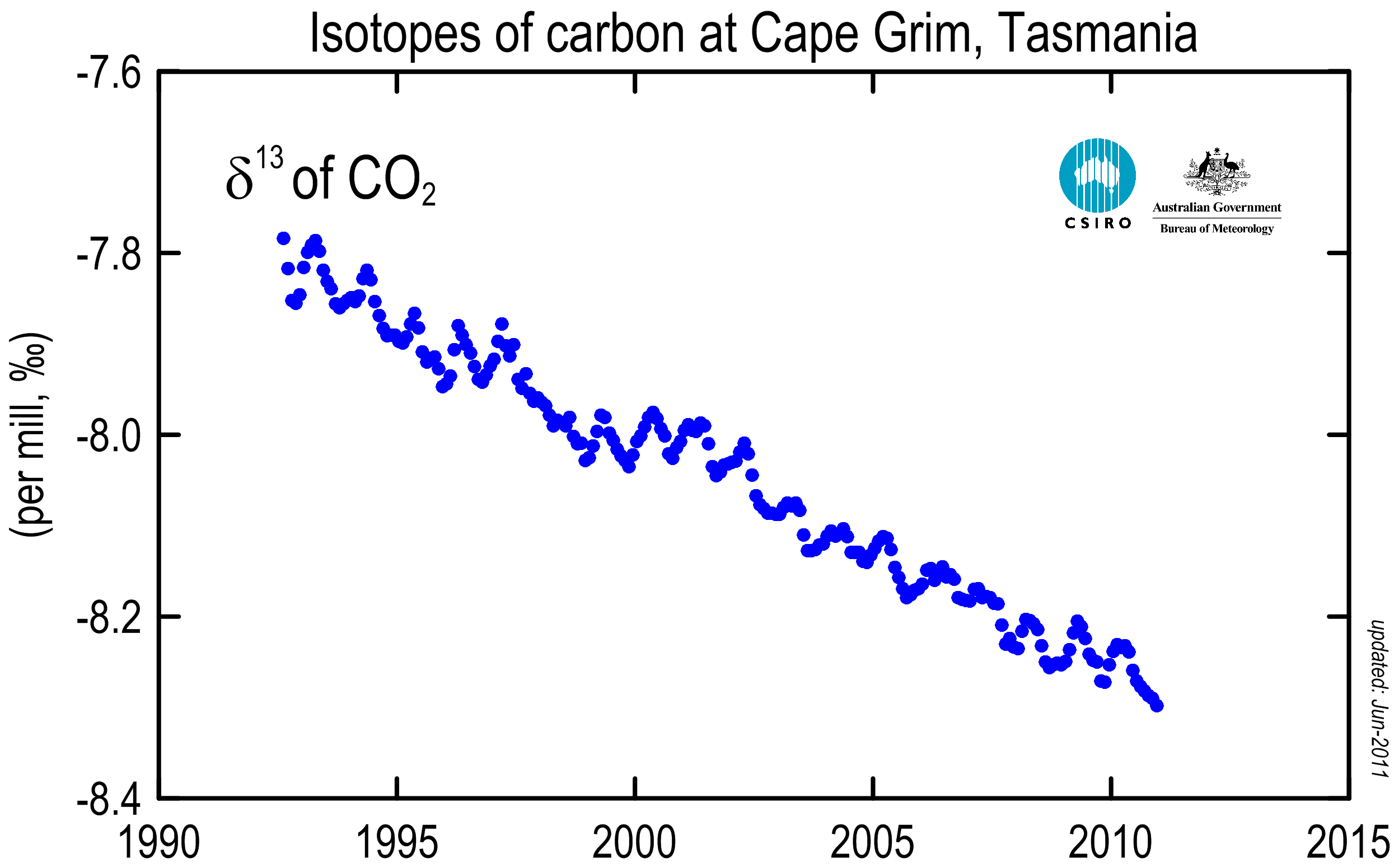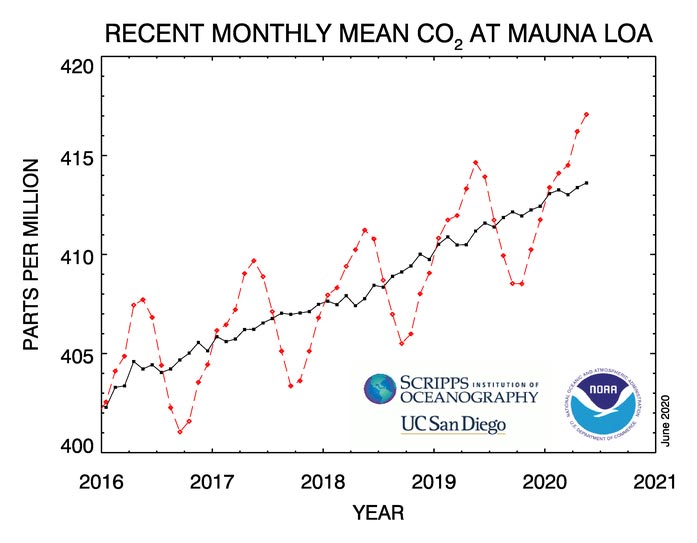THE HOCKEY SCHTICK Climate scientist Dr. Murry Salby explains why man-made CO2 does not drive climate change
- CO2 lags temperature on both short [~1-2 year] and long [~1000 year] time scales
- The IPCC claim that "All of the increases [in CO2 concentrations since pre-industrial times] are caused by human activity" is impossible
- "Man-made emissions of CO2 are clearly not the source of atmospheric CO2 levels"
- Satellite observations show the highest levels of CO2 are present over non-industrialized regions, e.g. the Amazon, not over industrialized regions
- 96% of CO2 emissions are from natural sources, only 4% is man-made
- Net global emissions from all sources correlate almost perfectly with short-term temperature changes [R2=.93] rather than man-made emissions
- Methane levels are also controlled by temperature, not man-made emissions
- Climate model predictions track only a single independent variable - CO2 - and disregard all the other, much more important independent variables including clouds and water vapor.
- The 1% of the global energy budget controlled by CO2 cannot wag the other 99%
- Climate models have been falsified by observations over the past 15+ years
- Climate models have no predictive value
- Feynman's quote "It doesn’t matter how beautiful your theory is, it doesn’t matter how smart you are. If it doesn’t agree with the data, it’s wrong" applies to the theory of man-made global warming.
1) CO2 lags temperature on both short [~1-2 year] and long [~1000 year] time scales
CO2 can obviously be added to the Earth's atmosphere. Hypothetically, the Martians could fly huge tanker trucks here and simply release it in to the atmosphere. It is not impossible to artificially increase the level of CO2 - or of any other gas - in the Earth's atmosphere. The obvious source for the 280 ppm increase since 1750 has been the combustion of fossil fuels. And since 280 of the current 400 ppm in the Earth's atmosphere present the isotopic signature of having come from burned fossil fuel, the question is settled.
2) The IPCC claim that "All of the increases [in CO2 concentrations since pre-industrial times] are caused by human activity" is impossible
Why? As just explained, that is precisely what the evidence indicates.
3) "Man-made emissions of CO2 are clearly not the source of atmospheric CO2 levels"
Why not? The excess CO2 gives undeniable isotopic indication that it came from burning fossil fuels?
4) Satellite observations show the highest levels of CO2 are present over non-industrialized regions, e.g. the Amazon, not over industrialized regions
High CO2 levels will be found over large fires. That does not mean they have been the primary source of added CO2 over the last 150 years. CO2 from forest fires does not possess the isotopic signature of CO2 originating from the combustion of fossil fuel.
5) 96% of CO2 emissions are from natural sources, only 4% is man-made
CO2 has a long lifetime in the atmosphere. The small excess being created by humans will accumulate for centuries. Over the same time scale, investments grow significantly at similar annual rates.
6) Net global emissions from all sources correlate almost perfectly with short-term temperature changes [R2=.93] rather than man-made emissions
This seems to be saying that net global CO2 emissions correlate well with short term temperature changes. If by "almost perfectly", you mean "within 4%", this would roughly be the case. Humans ARE emitting CO2 into the atmosphere and are responsible for almost every bit of the increase since the beginning of the Industrial Revolution. That amount is only a small portion of the Earth's natural, seasonal flux. But it IS excess, it IS long-lived and it IS responsible for the atmospheric build up.
7) Methane levels are also controlled by temperature, not man-made emissions
No one has suggested otherwise. Relatively small amounts of methane are released through leakage, but keep in mind that for humans, methane is a fuel. We don't want to release it. We want to burn it for energy. Released methane has a much shorter lifetime than CO2 so any excess produced by humans has little chance to build. And enormous amounts of methane are held in solution in Arctic tundra and in methane clathrates on the ocean floor, vulnerable to release from heating. None of this should make you feel any less nervous, of course. Methane is a powerful greenhouse gas and warming the planet and putting all that naturally sequestered methane at risk of emission is precisely what we continue to do.
8) Climate model predictions track only a single independent variable - CO2 - and disregard all the other, much more important independent variables including clouds and water vapor.
Bullshit.
9) The 1% of the global energy budget controlled by CO2 cannot wag the other 99%
It most certainly can. And, it was 4% a few lines back. What happened?
10) Climate models have been falsified by observations over the past 15+ years
Most climate models did not predict the hiatus, but they have tracked our climates behavior far better than is generally indicated in denier literature (such as Roy Spencer's embarrassing pack of lies). No one has ever made a CGM that came within an order of magnitude of reality WITHOUT assuming anthropogenic global warming from CO2 emissions. Ever.
11) Climate models have no predictive value
Just like assholes, everyone's got an opinion and most of them stink. Models most certainly DO have predictive values. Models are the only thing we have, in ANY field, with which to make predictions. If models don't do it, we can make no predictions ABOUT ANYTHING. If you think that's the case, you're simply wrong.
12) Feynman's quote "It doesn’t matter how beautiful your theory is, it doesn’t matter how smart you are. If it doesn’t agree with the data, it’s wrong" applies to the theory of man-made global warming.
Fine. The data say that humans are responsible for almost every bit of the excess CO2 in the atmosphere and that CO2 is the primary cause of the global warming experienced over the past 150 years. So... what was your point?



